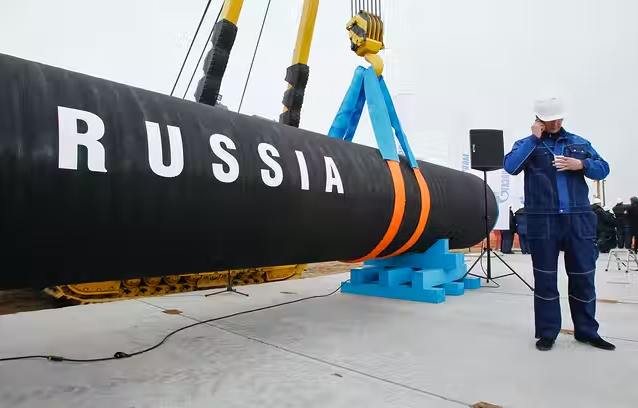董汀:清华大学战略与安全研究中心助理研究员

2022年3月24日,北约、七国集团和欧盟史无前例地在同一天召开峰会。会后美国总统拜登与欧盟委员会主席冯德莱恩在布鲁塞尔宣布成立能源安全联合工作组,双方旨在通过多样化欧洲天然气供应来源和能源品类,摆脱对俄罗斯化石燃料的依赖,加强欧洲能源安全。
联合宣誓是对2月24日之后美欧紧锣密鼓迈向能源供应“去俄罗斯化”政策的强力背书。3月8日,美国宣布禁止进口俄罗斯油气,欧盟表示年内将对俄天然气进口量削减三分之二;3月10日,欧盟凡尔赛峰会提出将于2027年终止使用俄罗斯石化能源。甚至还有德国政客呼吁民众,就算在室内穿上毛衣御寒也要抵制俄罗斯提供的油气。在战争炮火的反衬下,跨大西洋联盟自甘牺牲短期能源供应稳定,以清洁能源为愿景,坚定的外交“团结秀”看起来稳占明德(moral clarity)高地。
作为美国里根总统的外交成功之道,使用“明德”进行国内外动员是美国政府常用的政策工具。但是在代代相传中,“明德”逐渐被片面解读,与道德陈述简单等同。然而无论是从里根最初运用这一工具的综合手法来看,还是从“明德”哲学词意的本身出发,所谓“明”,不仅是清晰定义道德价值,更是明确实现这种道德立场所要基于的客观事实,具体问题具体分析。
本次明德外交中,舆论场上特别着重凸显各方摆脱俄罗斯能源供应的“决心”:俄乌冲突之初,西方对俄制裁一度谨慎地绕过能源贸易领域,但随着战事发展,不仅美欧政府宣布停止或减少对俄能源进口,连欧美能源公司也不愿成为“同谋”,纷纷主动行为,限制对俄交易。鉴于俄罗斯是世界最重要的能源供应国之一,提供着全球超过四成的化石能源产品,在这种体量背景下依然坚持“去俄”,强烈对比营造出很好的叙事效果。
而关于能否摆脱俄罗斯能源供给,包括欧洲顶尖经济研究智库布鲁盖尔研究所在内,诸多机构和学者都从多样化供应替代能力和传输基础设施现状的角度展开测算评估,部分认为,假以时日,能够达成相对乐观的目标。但俄罗斯与全球能源市场的深度融合,是能源价值链中全体行为者长期复杂互动的结果。仅仅从外交目标出发,聚焦供应能力的观察方法可能无法充分解释能源领域的完整现实态势。
先看欧洲。过去十多年,欧盟一直在追求“能源自主”,但各种复杂因素导致进度缓慢。俄乌冲突发生后不久,2月27日,英国石油率先宣布将所持俄罗斯石油公司股份全部抛售,包括资产价值和累积外汇损失在内,可能导致总计高达250亿美元的损失。事实上,英国石油从2005年已经开始出售自身石化资产,启动迈向新能源业务转型的进程。2020年,公司发布十年战略,规划到2030年将油气日产量减少100万桶当量,同时大力推进可再生能源开发,吸引有助于绿色转型的长期投资。
英国石油现在从俄油获得的日产量为110万桶当量,不惜重创毅然退股为企业营造的良好形象也将有助于吸引更多以环境、社会和治理(ESG)为导向的清洁能源投资者。此外,按照测算,布伦特原油价格每增加1美元/桶,英国石油就会增加3.4亿美元的营业利润。综合上述因素,考虑到能源价格企高、全球需求走强的前景,以及俄油股份最终何时能以公允价值出售尚不确定等因素,英国石油的撤股未必有表面看上去那么悲壮。耐人寻味的是,为了获得俄罗斯天然气的有力替代,英国石油转向了更多所谓“非民主”国家进行投资,其中产量寄望最高的阿塞拜疆沙赫·德尼兹(Shah Deniz)气田,环境破坏和腐败现象极为严重,却在媒体鲜有曝光。
壳牌公司跟随英国石油表态将对俄发起制裁,但不足一周后,却被报道在原有长期合同之外,以低价额外收购了72.5万桶俄罗斯原油。虽然壳牌立即致歉并承诺将停止购买俄罗斯油气,但也坦言短期内无法停止与俄罗斯签订的长期能源采购合同。壳牌与萨哈林-2号天然气项目每年100万吨的承购合同目前签到2028年,与俄罗斯天然气公司诺瓦泰克(Novatek)的合同还有13年执行期。由于英国交通部发布的禁令仅仅限制俄罗斯船籍的船只入境,3月4日,最新一船来自俄罗斯的天然气在威尔士靠港。船上所载气量据称可以满足整个月内全英约三分之一的日常需求。而由于电费和燃气费翻倍,英国民众年内面临380亿英镑的额外家庭支出。
俄乌冲突前,美国百般阻挠的俄欧“北溪2号”天然气管道项目已经陷入困境。2021年11月,德国默克尔政府宣布因为技术原因暂停了北溪2号天然气管道认证程序。朔尔茨执政后,俄乌冲突升级美国制裁风险加大,迫于内阁内部党争压力,新政府确认暂停认证程序。随后,主要运营企业俄罗斯天然气工业股份公司(Gazprom)在瑞士注册的管道公司提出考虑申请破产。尽管如此,整个3月份,俄气输入主要外国市场的日均气流量已飙升至7个月以来的最高水平。法国燃气集团(Engine)、法国道达尔(TotalEnergies)集团明确表示无法停止对俄罗斯天然气采购。意大利国家电力公司(Enel)、埃尼集团(Eni)仅表示有停止采购俄罗斯油气产品的计划。
但是俄罗斯因制裁被隔离在全球支付体系之外,很难获收能源交易以美元和欧元结算的应收帐款。普京提出将从4月1日起,仅接受卢布作为天然气交易结算货币。此举立即推高了欧洲天然气价格和布伦特原油价格,也使得欧洲能源公司面临违约风险。包括壳牌石油和德国能源集团(Uniper)在内的欧洲能源巨头立即向欧洲央行极力游说,希望获得紧急资金或者合同违约时的相应基金或机制支持,却遭到了拒绝。
再观察美国的情况。美国仅有8%的原油来自俄罗斯,所以减少和取消相应进口对国内能源供应影响有限,美国雪佛龙公司(Chevron)在委内瑞达和哈萨克斯坦运营的油井成为最大的替代希望。虽然委哈两国探明的储量可观,但委内瑞拉长期受到制裁拖累,哈斯克斯坦政局动荡,2020年雪佛龙已经锐减对哈投资,并解雇了近4万名本地员工。
埃克森美孚公司宣布中止在萨哈林-1号项目的运营,并表示将开始制定退出计划。美孚开始从哈萨克斯坦购买石油加以替代,通过里海石油管线(CPC)完成运输。虽然管道在运营管理上分为哈萨克斯坦和俄罗斯两个分支,但里海管线公司最大股东是俄罗斯国家石油管道运输公司。不巧的是,受暴风雨天气影响,管道3月下旬进入停运维修,预计最长需要两个月时间。
对于拜登政府来说,更急迫的事情并不只是寻找石油替代。俄乌冲突以及美国为首的强力制裁带来的国际地缘政治风险预期,造成国际能源市场价格持续波动,全美各州平均汽油价格已经打破了历史最高记录。美国最新一项民意调查发现,近四成的民众将高油价归咎于拜登政府。中期选举日益临近,民主党不得不采取行动减轻政治损害。4月1日,拜登宣布了史上最大规模的战略石油储备释放计划。理论上,供应量激增短期内能够有效拉低汽油消费价格,但这样一来,向市场释放出的信号不仅会使得精炼商因为预期利润降低而减少原油采购,更将导致高需求状况持续。事实上,美国的汽油储备目前处在五年均值水平,并没有严重短缺,需求膨胀才是目前油价高企的根本原因。此外,拜登政府计划六个月内每天释放100万桶石油,而从美国国内物流能力上来看,每天能够完成的最大运力只能达到4000-5000桶。
目前看来,能源结构转型是解决对俄能源依赖的终极方法,但加入了所谓“净零银行联盟”的全球最大60家银行仍在向传统石化能源公司提供巨额融资,2021年融资总额同比增长了约100亿美元。其中居于首位的是美国摩根大通银行,它也是过去六年来俄罗斯国家能源公司的最大资方。在清洁能源发展所不可或缺的核能领域,美国全境93个商业核反应堆所需的铀均主要依赖从俄罗斯和俄盟国进口,按照美能源部的说法,替代来源还在寻找过程中。而且在全世界范围内,先进核反应堆使用的高纯度低浓铀燃料(High-Assay Low-Enriched Uranium,HALEU)目前只有俄罗斯和美国两个供应来源。
全球能源图景的现实细密复杂,除了计算替代供应量的数字,观察运输基础设施的布局之外,还要考虑替代来源政治、经济和企业合同执行层面的可行性,金融市场的融资意愿,能源企业自身的运营需求,民众对消费油价和限量用气的承受能力以及能源品类多样性等诸多因素。因此,空前团结的跨大西洋联盟能否依靠道德宣誓实现能源去俄的政策目标依然值得继续观察。
How Far Can “Moral Clarity” Go?
On March 24, for the first time, NATO, the G7 and the European Union held summits on the same day. After the meetings, the U.S. and Europe announced the establishment of a joint working group on energy security, aiming to strengthen Europe’s energy security by diversifying European gas supply sources and ultimately moving away from dependence on Russian fossil fuels.
The joint statement is a strong endorsement of the U.S. and Europe’s respective “de-Russianization” energy policy after Feb. 24. Against the backdrop of battlefield fire, the transatlantic alliance is willing to forego short-term energy supply stability in favor of a vision of clean energy. This is a determined diplomatic show of solidarity that appears to be reviving the transatlantic notion of moral clarity.
Russia supplies 14 percent of the world’s crude oil and more than 40 percent of the EU’s gas. Many American and European foreign policy research institutions and scholars have examined the possibility of moving away from Russian supplies in terms of diversifying their alternatives in light of the current state of oil and gas supply infrastructure. Some have reached optimistic though guarded conclusions. But Russia’s deep integration in the global energy market is the result of a long and complex interaction of many actors in the energy value chain.
Let’s look at Europe first. The EU has been pushing for energy autonomy for more than a decade, but progress has been slow due to a variety of complications. On Feb. 27, BP was the first to announce that it was selling off its entire stake in Rosneft, which could result in losses totaling $25 billion, including the value of assets and accumulated foreign exchange losses. In fact, BP has been selling its petrochemical assets since 2005. The company plans to reduce oil and gas production by 1 million barrels equivalent per day by 2030, while attracting long-term investment to accelerate the green transition.
BP now receives 1.1 million barrels of oil equivalent per day from Rosneft. The company’s persistent departure from the stock at the expense of the losses will also help attract further ESG-conscious investors. According to estimates, BP’s operational profit will climb by $340 million for every $1 increase in the Brent crude oil price. Combining the aforementioned variables, BP’s withdrawal may not be as hard to suffer as it appears at first glance, given the prospect of higher energy prices, increased global demand and the uncertainty surrounding the eventual sale of all its Rosneft shares. It is intriguing to note that BP has turned to more so-called non-democratic countries for investment to secure a strong alternative to Russian gas, including the Shah Deniz gas field in Azerbaijan, which has the highest production expectations and has received little media exposure for its environmental degradation and corruption.
Shell followed BP in stating that it would launch sanctions against Russia, only to acquire 725,000 barrels of Russian crude at a low price less than a week later. While Shell immediately apologized and promised to stop buying Russian oil and gas, it also admitted that it could not instantly terminate its long-term energy purchase contracts with Russian companies, which have remaining performance periods ranging from 6 to 13 years.
A shipment of gas from Russia docked in Wales on March 4, as the ban issued by the UK Department for Transport restricted entry only to vessels registered in Russia. Throughout March, the average daily flow of Russian gas into major foreign markets has soared to its highest level in seven months. Additionally, the British public faces an extra £38 billion in annual household expenses as electricity and gas bills double.
Russia announced in response to financial sanctions that as of April 1, only rubles would be accepted as the settlement currency for gas transactions. The decision immediately pushed up the international price of oil and gas and put European energy companies at risk of defaulting on their contracts. European energy giants, including Shell Oil and German Energy Group, immediately lobbied the European Central Bank for emergency funding or corresponding funds or mechanisms to support them in case of contractual default, but were rejected.
Now, let’s look at the situation in the United States. The U.S. imports only 8 percent of its crude oil from Russia, and reducing or canceling those imports will have only limited impact on American energy supplies. The wells in Venezuela and Kazakhstan operated by Chevron have emerged as the best hope for replacement. While both Venezuela and Kazakhstan have significant proven reserves, Venezuela’s role in the global energy trade has been hampered for years by sanctions. Kazakhstan remains in political turmoil, and Chevron significantly reduced its investment in Kazakhstan in 2020, laying off nearly 40,000 local employees.
ExxonMobil announced it was suspending operations at the Sakhalin-1 project and began buying oil from Kazakhstan instead, completing shipments via the Caspian Pipeline Consortium. Although the consortium is operationally divided into two branches, Kazakhstan and Russia, Transneft is the largest shareholder. Unfortunately, because of stormy weather, the pipeline was forced to shut down in late March for maintenance, which is likely to last up to two months.
Increased geopolitical risk is expected to cause prices to be volatile in international energy markets, and average gasoline prices across the U.S. have broken all-time highs in every state. According to a recent poll in the United States, roughly 40 percent of the public blames the Biden administration for rising gasoline prices. With the midterm elections looming later this year, Biden announced on April 1 the largest-ever release from the country’s strategic oil reserves to help lower consumer prices. But the policy signals to the market will not only cause refiners to cut crude oil purchases in anticipation of decreased profits but will also drive continued high demand.
In fact, U.S. gasoline reserves are currently at their five-year average level, indicating that there is no severe shortage. Inflated demand is the primary reason for current high oil prices. In addition, although the plan calls for a daily oil releases of 1 million barrels for six months, the average daily maximum logistics capacity in the United States is only 4,000 to 5,000 barrels.
While energy restructuring is widely regarded as the ultimate solution to dependence on Russian energy, the world’s 60 largest banks, which have joined the Net-Zero Banking Alliance, continue to provide huge amounts of financing to traditional fossil energy companies, with total financing increasing by approximately $10 billion year-on-year in 2021. At the top of the list is JPMorgan Chase, which has also been the leading banker for Gazprom over the last six years.
In the nuclear energy sector, which is integral to clean energy development, all 93 commercial nuclear reactors across the U.S. rely heavily on uranium imports from Russia or Russian allies, with alternative sources still in the process of being found, according to the U.S. Department of Energy. At the moment, Russia and the United States are the only two providers of high-assay low-enriched uranium, or HALEU, for advanced nuclear reactors.
The global energy landscape is networked and complex. This means that in addition to calculating alternatives for supply and observing the layout of transportation infrastructure, we need consider the feasibility of alternative sources at the political, economic and corporate contractual levels. Significant elements are government perceptions of the diversity of energy categories, the financial markets’ willingness to finance, the operational requirements of companies and the population’s ability to pay more for oil and its readiness to accept limits on gas consumption.
It remains to be seen whether or not the unprecedented unity of the transatlantic alliance can sustain sufficient “moral clarity” to achieve the eventual goal of breaking dependence on Russian energy. After all, moral clarity requires not only a precise description of moral value but also a precise characterization of the facts upon which such a moral value is to be established on a case-by-case basis.
This article was first published on China US Focus on April 11,2022.

